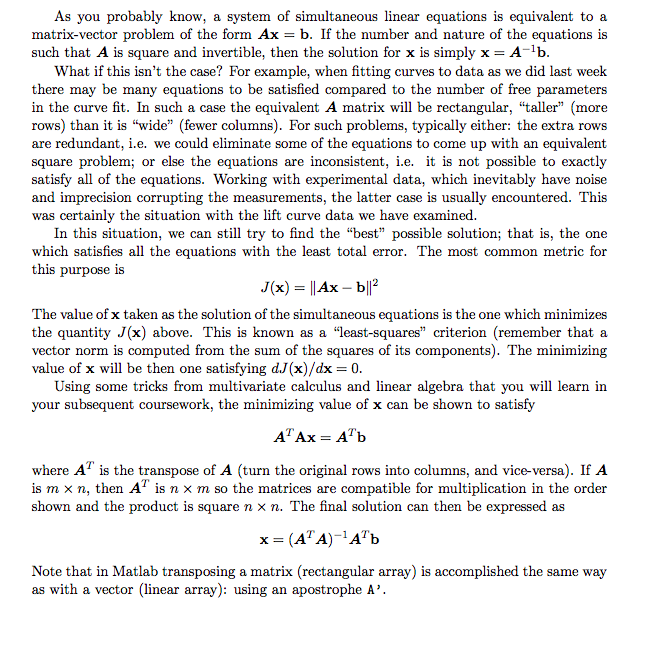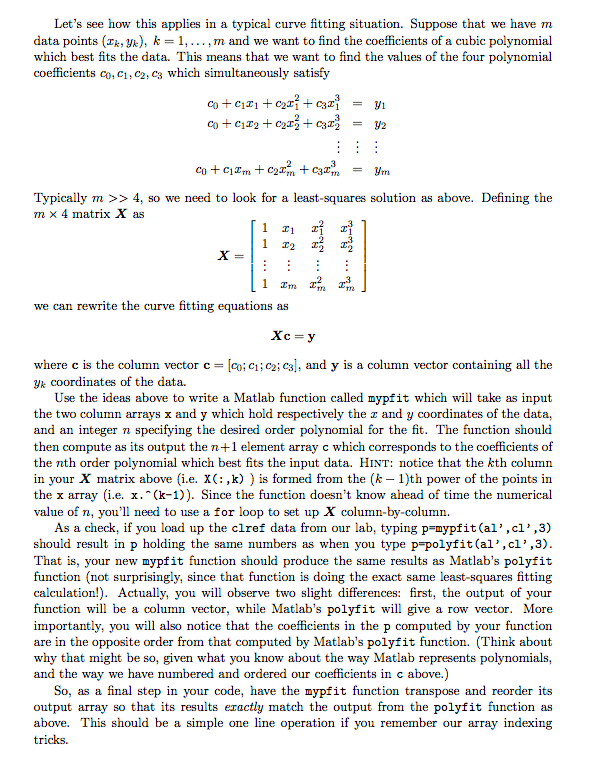

As you probably know, a system of simultaneous linear equations is equivalent to a matrix-vector problem of the form Ax - b. If the number and nature of the equations is such that A is square and invertible, then the solution for x is simply x = A- What if this isn't the case? For example, when fitting curves to data as we did last week there may be many equations to be satisfied compared to the number of free parameters in the curve fit. In such a case the equivalent A matrix will be rectangular, "taller" (more rows) than it is "wide" (fewer columns). For such problems, typically either: the extra rows are redundant, i.e. we could eliminate some of the equations to come up with an equivalent square problem; or else the equations are inconsistent, i.e. it is not possible to exactly satisfy all of the equations. Working with experimental data, which inevitably have noise and imprecision corrupting the measurements, the latter case is usually encountered. This was certainly the situation with the lift curve data we have examined. In this situation, we can still try to find the "best" possible solution; that is, the one which satisfies all the equations with the least total error. The most common metric for this purpose is J(x) = 11Ax-b112 The value of x taken as the solution of the simultaneous equations is the one which minimizes the quantity J(x) above. This is known as a "least-squares" criterion (remember that a vector norm is computed from the sum of the squares of its components). The minimizing value of x will be then one satisfying dJ(x)/dx 0 Using some tricks from multivariate calculus and linear algebra that you will learn in your subsequent coursework, the minimizing value of x can be shown to satisfy where AT is the transpose of A (turn the original rows into columns, and vice-versa). If A is m n, then AT is n m so the matrices are compatible for multiplication in the order shown and the product is square n n. The final solution can then be expressed as Note that in Matlab transposing a matrix (rectangular array) is accomplished the same way as with a vector (linear array): using an apostrophe A' As you probably know, a system of simultaneous linear equations is equivalent to a matrix-vector problem of the form Ax - b. If the number and nature of the equations is such that A is square and invertible, then the solution for x is simply x = A- What if this isn't the case? For example, when fitting curves to data as we did last week there may be many equations to be satisfied compared to the number of free parameters in the curve fit. In such a case the equivalent A matrix will be rectangular, "taller" (more rows) than it is "wide" (fewer columns). For such problems, typically either: the extra rows are redundant, i.e. we could eliminate some of the equations to come up with an equivalent square problem; or else the equations are inconsistent, i.e. it is not possible to exactly satisfy all of the equations. Working with experimental data, which inevitably have noise and imprecision corrupting the measurements, the latter case is usually encountered. This was certainly the situation with the lift curve data we have examined. In this situation, we can still try to find the "best" possible solution; that is, the one which satisfies all the equations with the least total error. The most common metric for this purpose is J(x) = 11Ax-b112 The value of x taken as the solution of the simultaneous equations is the one which minimizes the quantity J(x) above. This is known as a "least-squares" criterion (remember that a vector norm is computed from the sum of the squares of its components). The minimizing value of x will be then one satisfying dJ(x)/dx 0 Using some tricks from multivariate calculus and linear algebra that you will learn in your subsequent coursework, the minimizing value of x can be shown to satisfy where AT is the transpose of A (turn the original rows into columns, and vice-versa). If A is m n, then AT is n m so the matrices are compatible for multiplication in the order shown and the product is square n n. The final solution can then be expressed as Note that in Matlab transposing a matrix (rectangular array) is accomplished the same way as with a vector (linear array): using an apostrophe A








